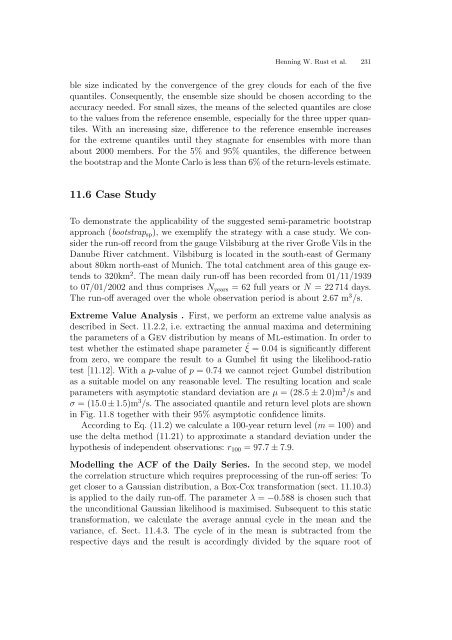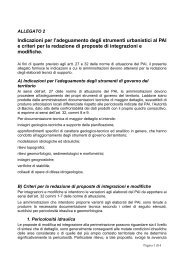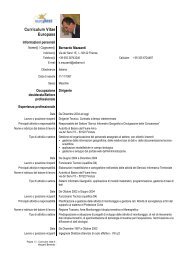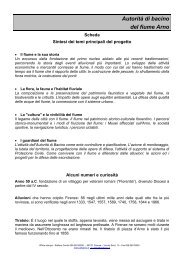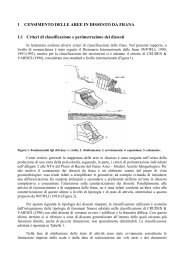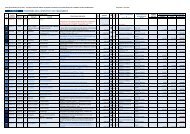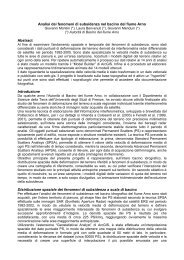11. Confidence Intervals for Flood Return Level Estimates assuming ...
11. Confidence Intervals for Flood Return Level Estimates assuming ...
11. Confidence Intervals for Flood Return Level Estimates assuming ...
Create successful ePaper yourself
Turn your PDF publications into a flip-book with our unique Google optimized e-Paper software.
Henning W. Rust et al. 231ble size indicated by the convergence of the grey clouds <strong>for</strong> each of the fivequantiles. Consequently, the ensemble size should be chosen according to theaccuracy needed. For small sizes, the means of the selected quantiles are closeto the values from the reference ensemble, especially <strong>for</strong> the three upper quantiles.With an increasing size, difference to the reference ensemble increases<strong>for</strong> the extreme quantiles until they stagnate <strong>for</strong> ensembles with more thanabout 2000 members. For the 5% and 95% quantiles, the difference betweenthe bootstrap and the Monte Carlo is less than 6% of the return-levels estimate.<strong>11.</strong>6 Case StudyTo demonstrate the applicability of the suggested semi-parametric bootstrapapproach (bootstrap sp ), we exemplify the strategy with a case study. We considerthe run-off record from the gauge Vilsbiburg at the river Große Vils in theDanube River catchment. Vilsbiburg is located in the south-east of Germanyabout 80km north-east of Munich. The total catchment area of this gauge extendsto 320km 2 . The mean daily run-off has been recorded from 01/11/1939to 07/01/2002 and thus comprises N years = 62 full years or N = 22 714 days.The run-off averaged over the whole observation period is about 2.67 m 3 /s.Extreme Value Analysis . First, we per<strong>for</strong>m an extreme value analysis asdescribed in Sect. <strong>11.</strong>2.2, i.e. extracting the annual maxima and determiningthe parameters of a Gev distribution by means of Ml-estimation. In order totest whether the estimated shape parameter ˆξ = 0.04 is significantly differentfrom zero, we compare the result to a Gumbel fit using the likelihood-ratiotest [<strong>11.</strong>12]. With a p-value of p = 0.74 we cannot reject Gumbel distributionas a suitable model on any reasonable level. The resulting location and scaleparameters with asymptotic standard deviation are µ = (28.5 ± 2.0)m 3 /s andσ = (15.0 ±1.5)m 3 /s. The associated quantile and return level plots are shownin Fig. <strong>11.</strong>8 together with their 95% asymptotic confidence limits.According to Eq. (<strong>11.</strong>2) we calculate a 100-year return level (m = 100) anduse the delta method (<strong>11.</strong>21) to approximate a standard deviation under thehypothesis of independent observations: r 100 = 97.7 ± 7.9.Modelling the ACF of the Daily Series. In the second step, we modelthe correlation structure which requires preprocessing of the run-off series: Toget closer to a Gaussian distribution, a Box-Cox trans<strong>for</strong>mation (sect. <strong>11.</strong>10.3)is applied to the daily run-off. The parameter λ = −0.588 is chosen such thatthe unconditional Gaussian likelihood is maximised. Subsequent to this statictrans<strong>for</strong>mation, we calculate the average annual cycle in the mean and thevariance, cf. Sect. <strong>11.</strong>4.3. The cycle of in the mean is subtracted from therespective days and the result is accordingly divided by the square root of


